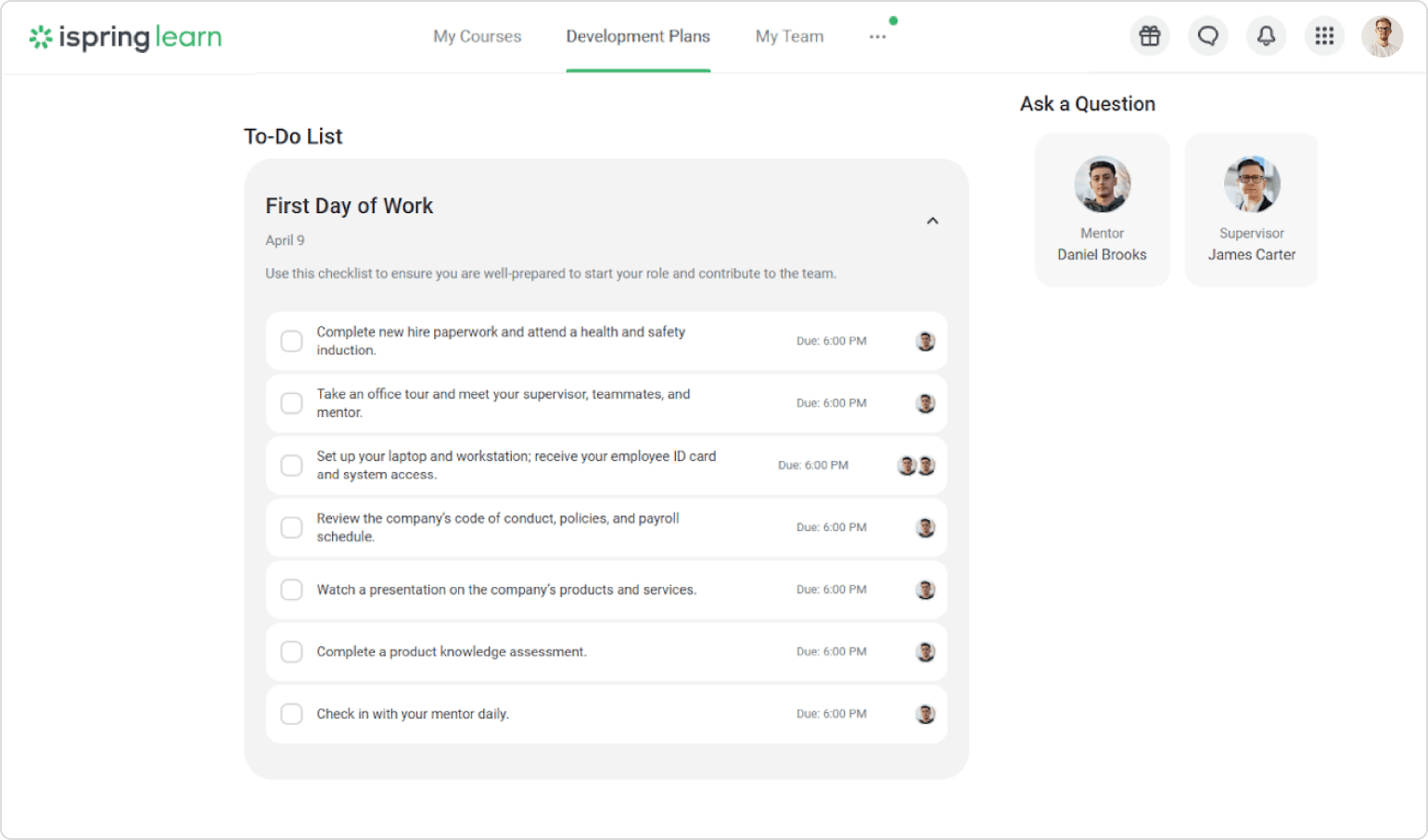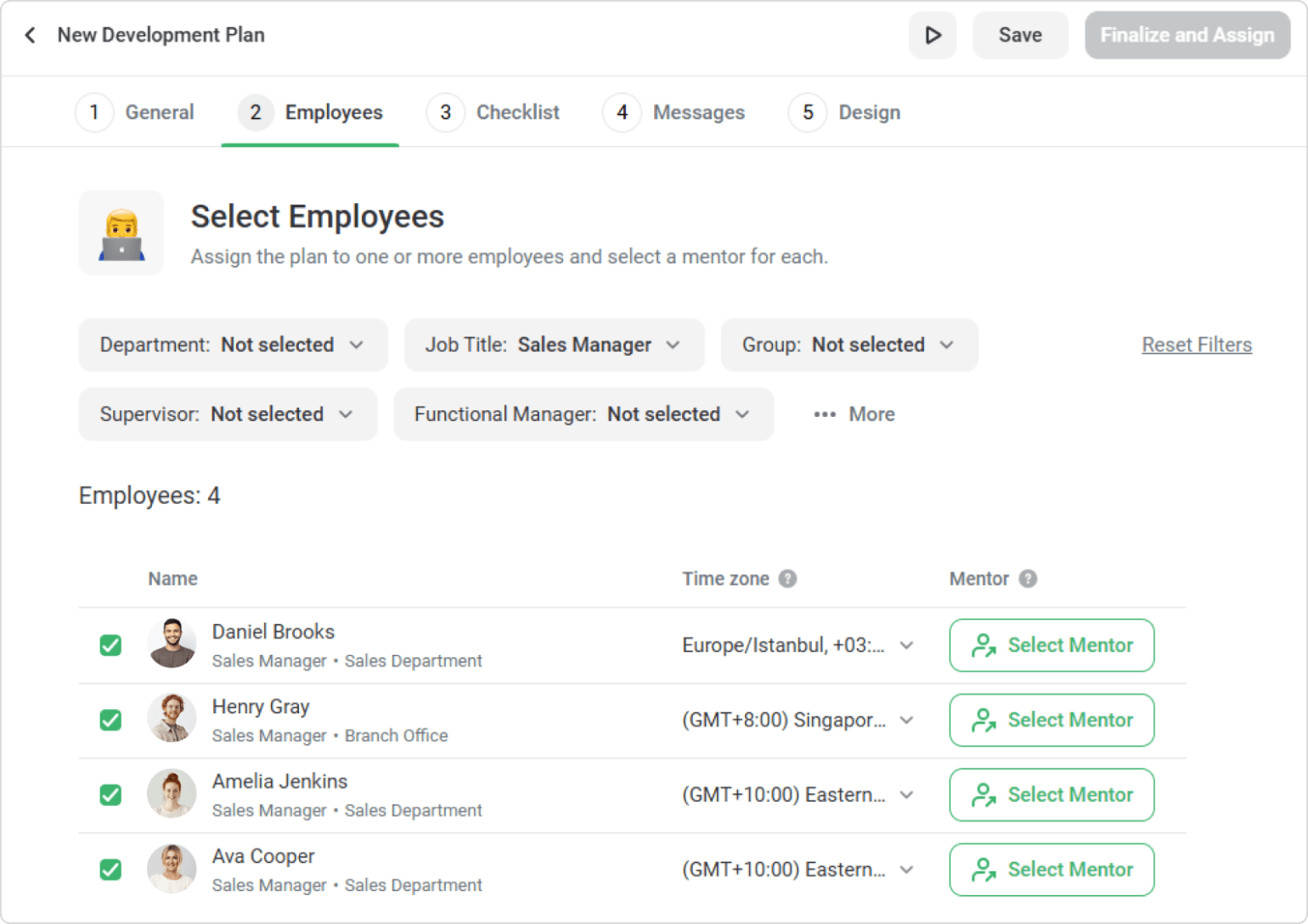Support Continuous Skill Development With An LMS
What keeps employees engaged and loyal to an organization? Sure, competitive compensation and perks matter, but people also look for growth opportunities. A strong development program signals that you invest in your team, and that investment increases employee productivity and satisfaction.
Yet, many companies still struggle to offer meaningful, ongoing development initiatives. Development resources are often scattered, poorly structured, and out of sync with employees' career goals.
The new Development Plans module in the iSpring Learn LMS helps make employee development effective, structured, and scalable. Use this step-by-step guide to build an employee development plan quickly and efficiently.
Why Move Employee Development Initiatives Online
Offering employee development online isn't just a trend; it's a smart, scalable solution to a real business challenge. In hybrid work environments, traditional training methods simply fall short: employees are juggling packed schedules, remote setups, and constant changes. Quarterly in-person workshops and cookie-cutter online courses don’t reflect how employees prefer to learn.
LMS-based employee development, on the other hand, is flexible, relevant, and actually helps people grow without disrupting their busy schedules.
It Supports Real-Life Work Challenges And Improves Productivity
Imagine your employee just started their onboarding journey or got promoted. They're adjusting to new responsibilities, receiving feedback, and building relationships with a new team. They don't need a workshop next month—they need support right now. Online development programs offer:
- On-demand access to learning
- Topics that match their current role
- Flexible pacing without falling behind on work
The wide variety of formats is another advantage: modern LMSs support interactive training formats that help employees retain what they learn long-term.
It Delivers Data-Driven Insights Without Micromanagement
A good LMS gives visibility into training progress without making people feel monitored. You can:
- Track engagement with the material
- Identify when someone might need extra support
- Make informed decisions about next steps
It Reduces Onboarding And Training Costs
Upskilling employees can get expensive fast. Between printing materials, booking rooms, and paying trainer fees, the costs pile up. Moving development online can cut these expenses without cutting corners on quality:
- Create once, reuse often. Build a solid onboarding or upskilling course once in your LMS, and reuse it for every new or promoted hire. Update it as needed, but there's no need to start from scratch every time.
- No need for constant live sessions. With video lessons, self-paced modules, and online knowledge checks, employees can learn without needing a trainer to walk them through every step.
- Less logistical overhead. You can forget about booking meeting rooms, planning for travel costs, or printing thick manuals for dozens or even hundreds of trainees.
Development Plans In iSpring Learn: LMS-Based Skill Growth Support Made Easy
If you want to launch your professional support initiatives in an LMS, be sure to choose a platform that does more than just deliver content. It should also help structure, track, and personalize employee growth over time.
iSpring Learn does exactly that. With the new Employee Development module, it makes online training and skill development efficient, structured, and scalable. You can use it to create and manage development initiatives like:
- Onboarding programs
- Internships
- Custom skill-building plans
- Ongoing professional growth paths
To make each initiative truly effective, consider adding:
- Custom checklists with action-based tasks for employees to complete at every stage
- Mentorship features for extra guidance and feedback
- Detailed progress reports to share with both trainees and leadership
- Customizable templates that can be adapted to different roles and skill levels

An example of an onboarding checklist in Development Plans.
With all these capabilities in one place, iSpring Learn helps you turn scattered development plans into a clear, structured process.
How To Create A Development Plan In iSpring Learn In 5 Steps
Building and launching an employee development plan in iSpring Learn is simple and straightforward. You can:
- Create and assign a new plan. Upload your existing training content and organize it directly within the Development Plans module.
- Create a plan template. Set up one or more plan templates tailored to different roles and adjust them to fit employee needs.
Let's see how to create a new plan and deliver it to employees.
1. Click Development Plans on the LMS sidebar. Then choose Assigned Plans and select Create Development Plan.

2. Fill in general information and go to the Employees tab to select trainees and their mentors. It's easy to find the right employee by entering their name or using smart filters like organizational departments.

3. Now assign a mentor or buddy. Assigning a mentor to your trainees is just as easy. Find them by their name or job title and add them as a mentor.
Pro tip: When deciding on a mentor, don't simply go for the most senior person in the team. Instead, choose mentors whose experience matches the trainee's current challenges and know relevant employee onboarding metrics. An employee who's recently solved the same issues successfully or mastered the same skills can sometimes offer more relatable guidance than a seasoned manager who's far removed from day-to-day tasks.
4. To help employees stay on track with their development programs, include checklists that break down tasks step by step. To create a checklist, open the Checklist tab. Next, select From Scratch. Once you have templates in place, you'll also be able to select checklists From Template.
You can set the plan and stage duration, edit stages, add tasks, and attach resources or instructions for employees. Set custom due dates and assign task monitors—supervisors, mentors, or managers to verify task completions. Once everything is set, select Create Task.
5. Finally, add messages for employees and customize the look of your development checklists. This makes the process feel more personal and relevant, which helps improve engagement with the training.
Pro tip: Use employee messages to explain why each task matters. A brief note about how the task connects to a real project or career goal can make it feel more meaningful and encourage stronger performance. A little context goes a long way. It's also a smart way to double-check whether each checklist item truly fits the role.
How To Check Skill Development Progress For Informed Decision Making
iSpring Learn's Team Development dashboard gives supervisors, mentors, and managers a real-time, practical view of how employees are progressing through their development plans. They can track completed tasks, missed deadlines, completion rates, and more.

To get more value from this data, follow these tips:
- Look into larger completion trends. Instead of only looking at who missed a deadline, try to spot whether certain types of tasks are regularly delayed. That might signal unclear instructions, poor time allocation, or a general skill gap.
- Use overdue tasks as conversation starters. If a task is overdue, that's a good moment for a quick check-in with the trainee. You'll show you're paying attention and ready to provide extra help.
- Monitor team-wide patterns. If several employees struggle with the same task or checklist stage, it may be time to tweak your content, assessments, or expectations. One change could lift outcomes for the whole group.
- Regularly share insights with leadership. Use the dashboard data to report not just on who's done what but also on how your team is growing, where they're excelling, and where investment is needed.
Remember to treat training analytics as a critical tool for spotting growth and employee potential. It's essential if you want to make well-thought-out decisions about promotions, role changes, or additional support.
Final Word
Effective development programs guide, support, and adapt to employees' needs. With iSpring Learn's Employee Development module, you can move beyond generic training and build clear, role-specific growth paths your team will actually follow.
Make time to review progress regularly, adjust plans based on feedback, and recognize even small wins along the way. And remember: collecting employee feedback is key. Ask your team members to rate each checklist item after completion—it's a quick way to identify what's useful, what's confusing, and where to improve your training approach. Continuous development works best when it's a two-way street.









